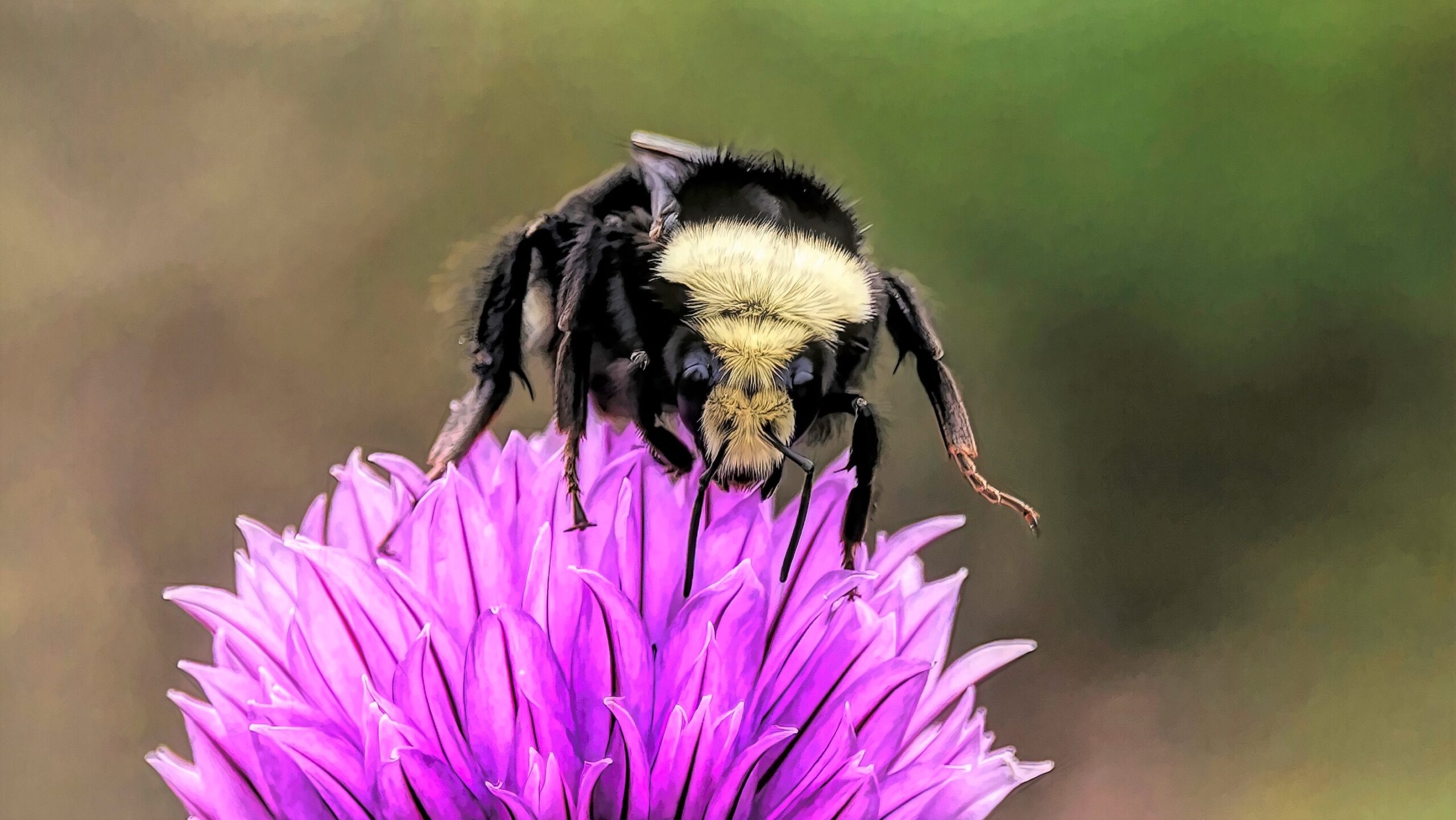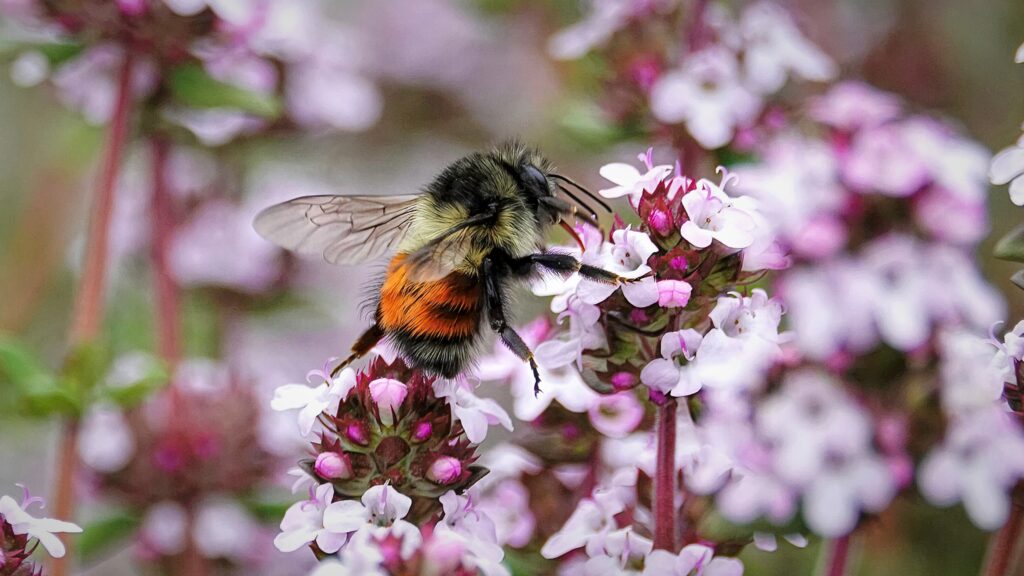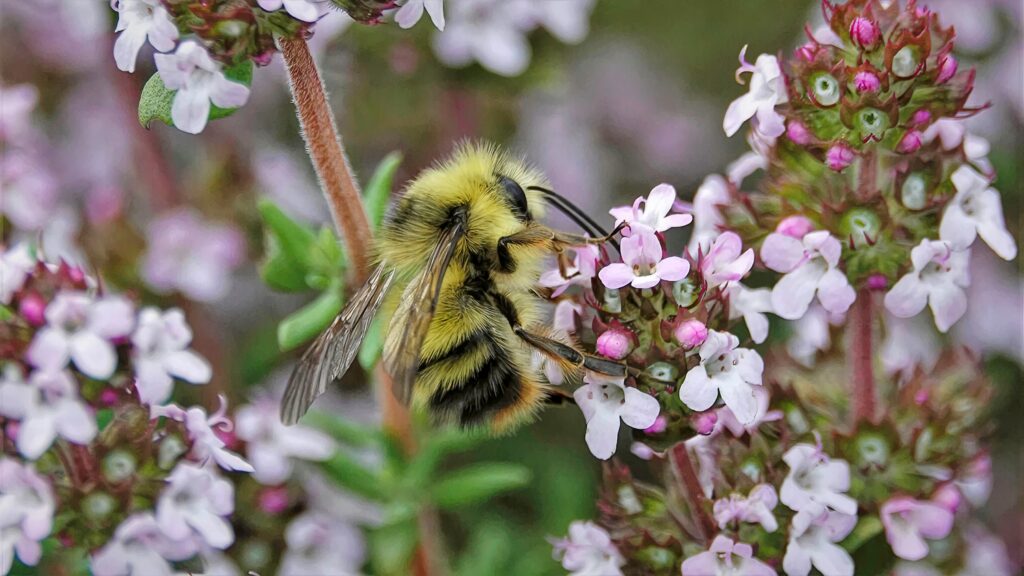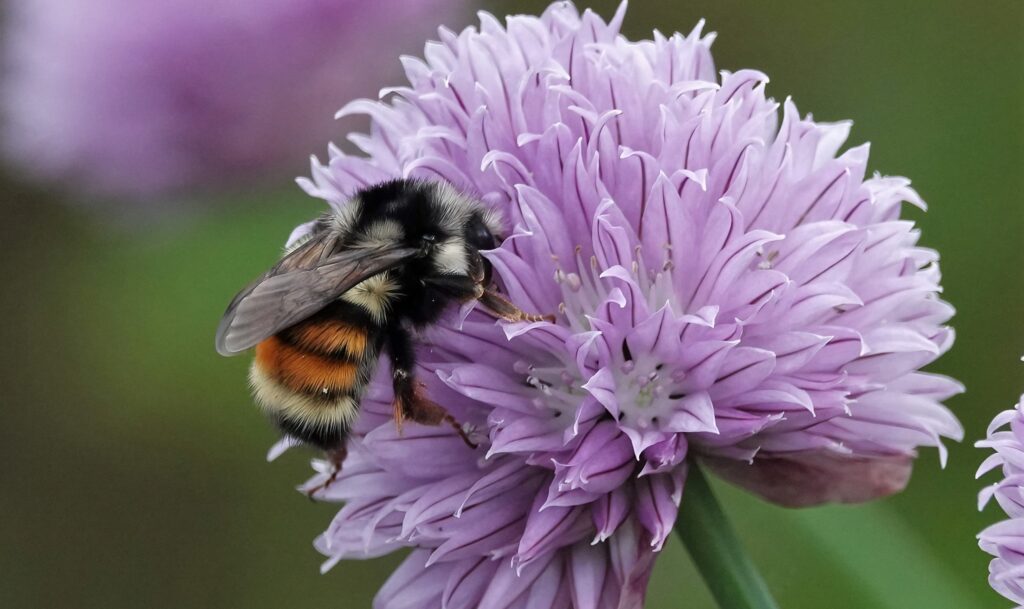By Lynda Stevens | 10 July 2022

This spring a medical issue has kept me mostly at home and able to walk only short distances with a walker. That meant that I was unable to get out walking on my favourite trails and exploring with my camera. However, in late May I discovered that one of my neighbours had a large herb garden in their front yard and it was humming with bees. So I started visiting this garden regularly since I could sit on my walker and observe, from the sidewalk, the bee activity in the chives and thyme which were in full bloom.
There were several varieties of bees visiting the flowers but the most numerous were the bumblebees, so I thought that this would be the perfect opportunity to learn about them. I started taking lots of photos and using them to try and see the differences in colours and banding that are used to separate the different varieties. The yellow-faced bumblebee, one of our most common species, was an easy one to identify since it is basically just black and yellow. But I soon discovered that other species can be tricky to ID since they show varying patterns of yellow, orange and black bands on their abdomens. Also, males can sometimes look different from females and even though queens and worker bees are both female they can show slightly different colour patterns as well. Luckily, by observing the bumblebees in the spring I was seeing mostly females, the queens and the workers, since the males don’t usually appear until later in the season. But even that can be unpredictable depending on species and how early in the spring the queens emerge from hibernation and start their nests. So, if you would like to try your hand at bumblebee identification, I would suggest starting as early as possible in the spring. Also, females can be easy to identify because only they carry pollen on specially designed structures on their hind legs. So, if you see a bee carrying balls of pollen you know that it is a female. The male bees that you will see visiting flowers later in the season are feeding on nectar but not collecting pollen.
So far, I have seen five different species of bumblebees in this herb garden and these are the commonest ones in our area. They are: Yellow-faced Bumblebee (Bombus vosnesenskii), Yellow-fronted Bumblebee (B. flavifrons), Fuzzy-horned Bumblebee (B. mixtus), Orange-rumped Bumblebee (B. melanopygus) and Vancouver Bumblebee (B. vancouverensis). I have included a few photos of these five species. I used iNaturalist to help me identify the bees and the common names are those used on the iNaturalist site.






During this learning adventure I was gifted a book called “The Bees In Your Backyard” by Joseph S. Wilson and Olivia Messinger Carrill which is a good introduction to all the bee species found in the US and Canada. It provides some stunning photos and, while not actually a field guide to the species found in our area, it is a good introduction to bees in general. The book describes their natural history, where they nest, how they gather food and their role as pollinators. Here are some interesting tidbits of information about bumblebees that I gleaned from this book.
- Bumblebees are in the Genus “Bombus” which comes from the Greek word bombos meaning “a buzzing sound”. The common name “bumblebee” can be traced back to the word bombelen in Middle English (AD 1200-1500) which means “to hum”.
- Bumblebees are found primarily in the northern hemisphere and, while they are found in a variety of habitats, they are most numerous in mountainous regions. Worldwide the areas with the highest bumblebee diversity are in Europe and Asia, particularly in the Himalayas and the Alps.
- Bumblebees are often the first bees seen in the spring and the last in the fall. They have adapted to colder weather in several ways: they have a thick and insulating coat of fur, they will bask in the sun to warm up before heading out to forage, and they are able to warm up by shivering their flight muscles. They can actually uncouple their flight muscles from their wings, allowing them to contract these muscles without flapping their wings. These muscle contractions will raise the internal temperature of the bumblebees making them warmer than their environment.
- Unlike honey bee queens, bumblebee queens live only for one year. They emerge from winter hibernation in the early spring, establish a new nest and then lay eggs on newly collected pollen and nectar. The first batch of eggs become the workers who collect more pollen and nectar for the growing hive. Later in the season eggs are laid that become new queens and also males whose only role is to leave the hive and mate with new queens from another hive. The worker and male bees die before winter and it is only the newly fertilized queens that hibernate through the winter.
- Like honey bees, bumblebees collect large amounts of pollen but they don’t turn this pollen into honey. Because bumblebee hives begin anew each year there is no need to store nectar as honey to feed the workers throughout the winter the way that honey bees do.
- Bumblebees are generalists and will feed on a wide variety of plants. Studies have shown that for many crops, pollination by bumblebees produces bigger fruit and larger yields than pollination by honey bees. Bumblebees have been shown to be faster workers than honey bees, often visiting twice as many flowers per minute. They also carry more pollen than honeybees and can work in colder temperatures.
- Most bumblebee species nest in the ground in pre-existing cavities such as abandoned rodent burrows, in piles of wood or leaf litter and sometimes even in building foundations. So, it is a good idea to have a messy garden and leave piles of leaves and sticks around to provide some nesting habitat.
Apparently, fourteen species of bumblebees have been recorded on Vancouver Island. Including these five in the herb garden, I have seen eight species, so I still have more hunting to do once I am able get out and about again. I hope that you have a better appreciation for these furry garden visitors and if you would like to try your hand at identification I can highly recommend the following reference:
A Field Guide to The Bumble Bees of Washington State https://washingtonbumblebees.org
